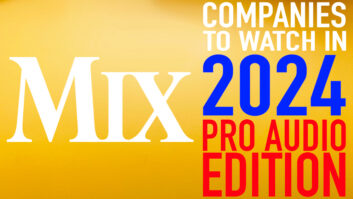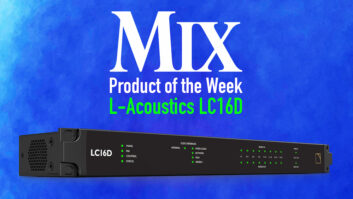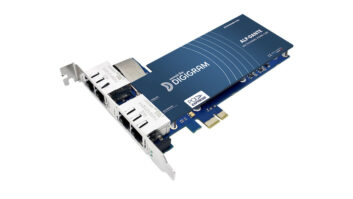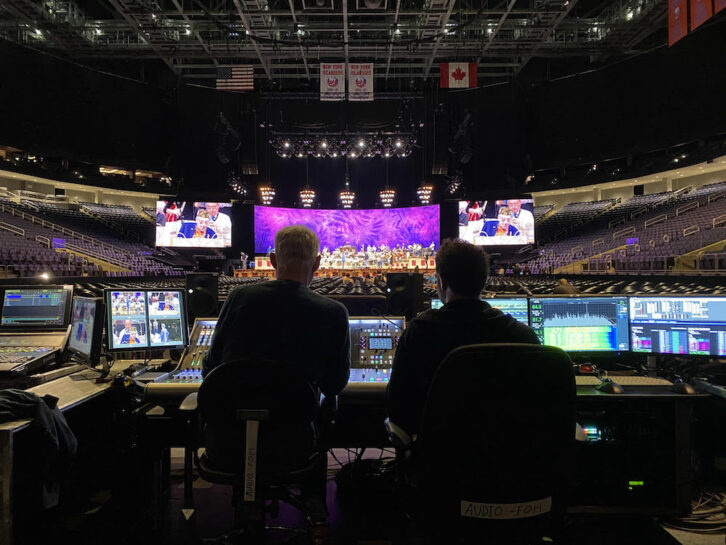
Elmont, NY (November 20, 2023)—Andre Rieu may be a force of nature. The 74-year-old Dutch violinist has spent a lifetime bringing his populist take on classical and waltz music to the world. With his 60-piece Johann Strauss Orchestra—reportedly the largest private orchestra on the planet—Rieu has regularly played 80 to 100-plus performances a year for decades, each show before crowds ranging from 5,000 to 15,000 a night. Intriguingly, most Rieu concerts take classical music out of traditional bastions of high culture like symphony halls, and bring it to modern places people are more familiar with, like open-air festivals and arenas.
The day Mix caught up with Rieu’s fall North American tour, the production was ensconced inside UBS Arena in Elmont, New York. Less than two years old, the new home of the Islanders NHL team was filled with the sound of well-known pieces from the classical canon— but while the music was sometimes centuries old, the technologies that brought it to the packed house were as up-to-date as any other arena tour.
Much of that had to do with Montreal-based Solotech, Rieu’s audio provider for more than a quarter-century, which was additionally handling IMAG cameras for the tour. Rieu’s productions are such an integral part of Solotech’s history that working on his tours is almost a rite of passage. Alexandre Dugas, crew chief/system engineer, explained, “If you go to the office in Montreal, talk with all the supervisors and coordinators, and ask, ‘Hey, you did the Rieu tour?’ They’ll say ‘Yeah, I did that from 2002 to 2008’—and everybody’s been on this tour. It’s always big shoes to fill.”
Natalie Merchant Returns to the Road
Dugas wears some of those shoes himself, having circled the world with Rieu’s retinue for a decade: “I have probably done this show 700 times; I love being on this tour. It’s different from the rest because it’s a full-time job for me. I don’t do other tours; I barely even do other gigs— sometimes a festival or two in the summer, but he does 90 shows a year, every year. We started at the end of August at Formula One in Zandvoort in the Netherlands, because he was playing the national anthem; then we went to Maastricht, where he lives; now we’re on the U.S. tour and then we go back for Germany.” That doesn’t even mention the other Maastricht concerts performed earlier in the summer, where they played for nearly 250,000 people across 16 nights in an outdoor square.
No matter where Rieu and his orchestra play, however, Solotech is always on-hand. “From what I heard,” says Dugas, “back in ’97 in Quebec City, he did a show and got local PA from Solotech. They arrived with a Meyer rig—MSL, CQ2s and UPAs—and at soundcheck, he said, ‘Wow, what is that? I want this all the time, everywhere!’ Solotech sent a container full of gear and some guys over, and it’s been going on for 25-years-plus.”
The audio gear has changed many times since then and these days, the production carries it all. “It just comes with us; we can’t start from scratch everywhere,” said Dugas. “We did for a few years when we had a Yamaha PM1D console, but try to find local PM1Ds in China. Now my tour package is compact and really efficient. It’s constantly evolving, one thing at a time.”
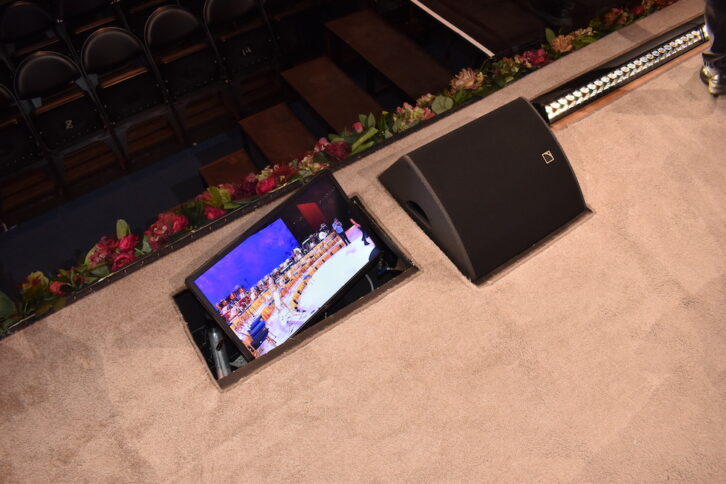
Even today, the use of sound reinforcement is still controversial in some corners of the classical world, but the venues on Rieu’s tour itineraries make it a necessity. With that in mind, the tour carries an L-Acoustics K2 PA, with 16 boxes on the mains and 12 on the side.
Those are supplemented by KS28 subwoofers on the floor and a string of Kiva boxes used for front fills, hidden behind acoustic mesh on the front of the stage to provide a cleaner look while still covering the first rows. Despite all that firepower, the typical Rieu concert is relatively quiet, averaging 85 dBA, though the dynamics of classical staples like “Bolero” can drive it up a ways to get the blood pumping at the end of the night.
Monitoring for the production is relatively simple—there’s no IEMs in play and, for that matter, no monitor engineer; given the mere handful of monitors necessary, a house mix comes out of four L-Acoustics four X12 across the front of the stage, partially embedded into the deck to keep a low profile. Elsewhere, X8 speakers are judiciously used for musicians near the trumpet section as well as the space where a gospel choir comes on for four songs.
Miking on stage is primarily a selection of DPA 4000 series microphones, but there’s also a passel of Neumann KM 184s and TLMs in use, and Sennheisers on the open-lid Fazioli piano. Rieu himself wears two lavaliers, and all wireless mics onstage are tied to Shure Axient Digital systems.
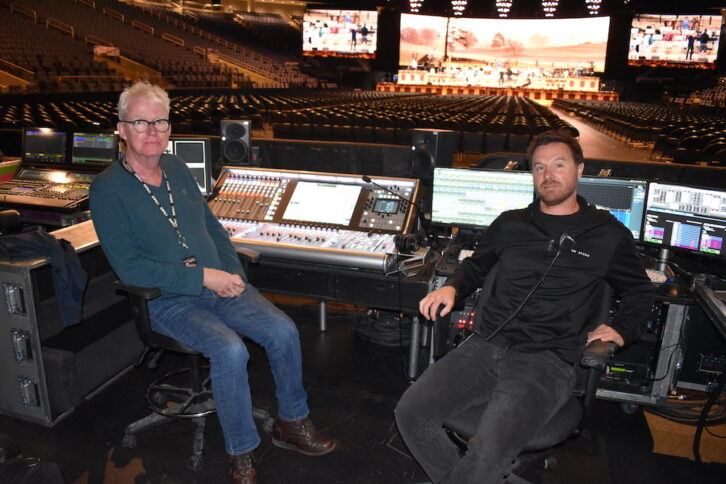
The front-of-house mix position finds Rieu’s longtime engineer, Wim Van der Molen, overseeing a Solid State Logic Live L550, while Dugas keeps tabs on QLab, Wavetool and a variety of Meyer Sound offerings like Compass, Galileo and Galaxy.
Rieu is a very proactive performer—all aspects of touring are coordinated in-house and he has a private recording studio/postproduction facility in Maastricht that knocks out albums, DVDs and TV specials seemingly nonstop. That hands-on mindset extends to soundcheck, too, as the entire orchestra soundchecks every day, giving him an opportunity to hear the room.
“When the soundcheck starts,” said Dugas, “I go in the front with my tablet, Andre comes off-stage, we’ll walk together all the way to front-of-house and he’ll have some comments about the sound, although most of the time not really because I know what he wants. Truthfully, in soundcheck, we are in rehearsal—but not that much for ourselves.”
Keeping with the production’s populist take on vintage music, local pipe and drum bands are recruited at each tour stop, so soundchecks are mainly an opportunity for them to practice cues and timing. The UBS Arena show had plenty of hometown bagpipes, but it added an even more unique local spin when 102-year-old saxophonist Dominick Critelli took the stage to sit in on Shostakovich’s “The Second Waltz.” Much of the soundcheck was spent getting everyone— from the orchestra to the audio team to Critelli himself—comfortable with the appearance, but it all came off without a hitch at showtime, making a once-in-a-lifetime performance all in a day’s work on the Andre Rieu tour.
